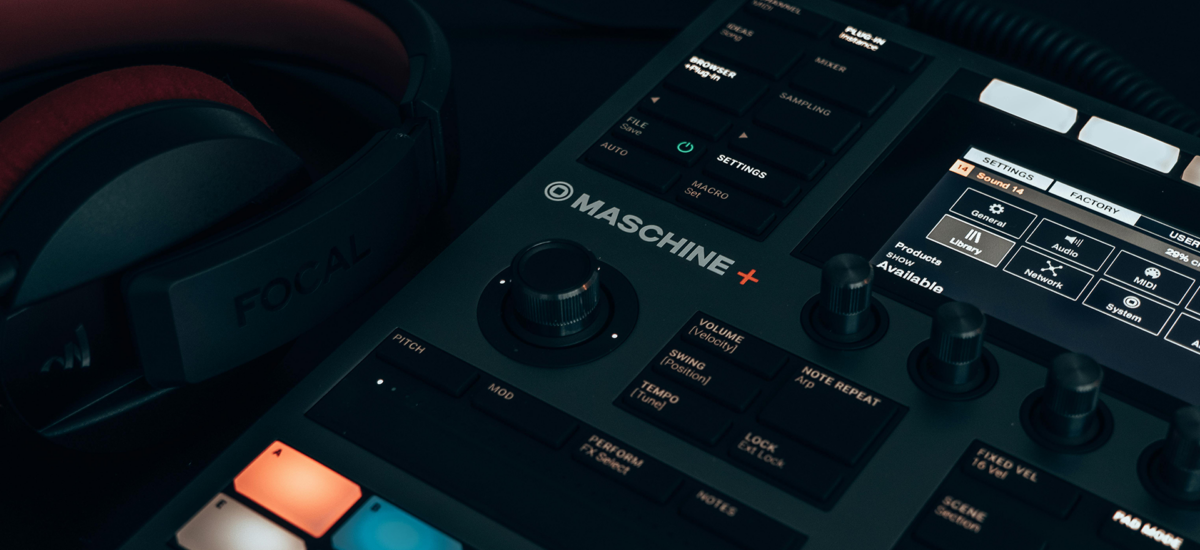
So much of hip hop is carried forward by rhythm and groove, including the vocals. But hip hop beats and instrumentals are what give the iconic hooks and verses legs to stand on. A significant part of this genre’s sound lies in its underlying harmonic structures — the chord progressions. Knowing at least a handful of essential hip hop chord progressions can transform your track into something captivating, regardless of whether you’re making hard trap or classic boom bap.
If you’re looking to create tracks that echo the brilliance of top-charting hits, you need to understand the way these progressions work. Let’s get into it and explore five common hip hop chord progressions that can help shape your sound.
Jump to these sections:
- What are hip hop chords?
- 5 popular hip hop chord progressions to use in your tracks
- Start creating chord progressions for interesting harmonic layers today
Follow along with this tutorial using Komplete Start.
What are hip hop chords?
Hip hop chord progressions often borrow from jazz and R&B progressions that use major, minor, and seventh chords to create different moods and tones. These progressions provide a harmonic backdrop that underscores the rhythmic and melodic elements of a track. While hip hop chords can range from simple triads to complex sevenths and ninths, understanding the basics is a fundamental step in writing your own hip hop chord progressions.
You should have a bit of music theory knowledge on scales and chords to get the full picture here. If you’re not totally comfortable with that, take some time to familiarize yourself with the basics of music theory and come back later.
Chords are, simply put, two or more notes playing at the same time. The simplest chords are called triads, and they are built by stacking up three notes we find in major and minor scales (you can also build chords from modes, but we won’t focus on that here).
If we take a C major scale and use alternating notes from it, we can create a basic series of triads.

Let’s build triads by taking one note from the scale, skipping the next, using the one after, and repeating until we have three notes to play simultaneously. Starting with C, we can skip D, use E, skip F, and use G again. This will leave us with C-E-G, which is a C major triad.
Here’s a quick rundown of chords in a C major scale to illustrate:
- I: C major
- ii: D minor
- iii: E minor
- IV: F major
- V: G major
- vi: A minor
- vii°: B diminished

We can do the same thing in minor keys. In this case, we’re using A minor, as it uses the same notes as C major.

Now we’re left with these chords:
- i: A minor
- ii°: B diminished
- III: C major
- iv: D minor
- v: E minor
- VI: F major
- VII: G major

In music theory we use Roman numerals to describe chords.
These chords are a starting point for constructing hip hop chord progressions that can range from dark and minor to uplifting and major.
What is the best chord progression for hip hop?
Hip hop is a generic term to describe a massive number of subgenres. What works for a laid-back lo-fi track might not fit in an intense trap banger. So there is no “best” chord progression for hip hop, but there are a handful of progressions that work across quite a few styles in hop hop.
While it is absolutely not a hard-and-fast rule, hip hop chord progressions tend towards being darker. Pop-adjacent artists like Doja Cat often deviate from these conventions, but it is something worth keeping in mind as we work through the hip hop chord progressions below.
5 popular hip hop chord progressions to use in your tracks
Now that we have a foundational understanding of hip hop chords, let’s get into specifics with five inspiring hip hop chord progressions. We’ll focus on examples in the key of C major or A minor to keep things simple, but you can transpose them to fit any key that suits your tracks.
1. ii-V-I: D minor – G major – C major
This progression is borrowed from jazz and is popular for its smooth, floaty sound. The ii-V-I progression lends itself to a polished, sophisticated vibe perfect for chill or soulful hip hop beats.
To make it sound more jazzy, add in seventh extensions:
This sequence is a staple in the hip hop world since lo-fi music exploded onto the scene. You can hear this progression’s influence on Tyler, The Creator’s “Boredom”. Be aware that producers and composers using the ii-V-I progression tend to modulate between different keys, and don’t usually cycle the chords in the same key:
2. i-III-VI-VII (or vi-I-IV-V): A minor – C major – F major – G major
The i-III-VI-VII can add a dark, dramatic element to a track. It’s commonly used in melodic trap music, where it can help create a psychedelic push and pull of tension and release.
This sequence is a go-to for many producers because of its subtle and emotional sound. You can hear it in Young Thug’s “Real In My Veins”:
3. i-VI-v-i: A minor – F major – E minor – A minor
This chord progression is especially popular in modern hip hop and trap music. It is dark and cyclical, which can set the scene nicely for storytelling through melodic flow.
The use of the minor v chord keeps the dominant harmony from feeling too tense, which helps with the chilled sound of this progression. It was solidified as one of the most iconic trap chord progressions since its use in “Mask Off” by Future:
4. III-i: C major – A minor
In a genre where the focus is generally on the vocals, simplicity can be a solid approach to beat making. This two-chord progression demonstrates that. The III-i sequence creates a sense of movement without straying too far from the tonal center, making it ideal for hooks and verses alike.
One way you can make such a simple chord progression a bit more interesting is through the use of chord extensions like sevenths and ninths:
This minimal approach can be powerful, especially when layered with a strong beat, a huge sub bass, and a melodic top line. You can hear it in action in “Rich Baby Daddy” by Drake ft. Sexyy Red & SZA:
5. i-VI-VII-iv: A minor – F major – G major – E minor
This progression is perfect for a more poppy hip hop sound, as it blends uplifting and melancholic tonalities. The i-VI-VII-iv pattern is common in hip hop ballads and tracks that mix emotional storytelling with hard beats.
Listen to this progression in G-Eazy and Bebe Rexha’s “Me, Myself & I”:
Start creating chord progressions for interesting harmonic layers today
Having a repertoire of common hip hop chord progressions at your fingertips is essential. The progressions we’ve discussed above have proven themselves by making appearances on charts time and time again.
Remember that chord progressions do not ‘belong’ to anyone, so feel free to use them in your own music. Experiment with these chord progressions in different keys and tempos to see how they can suit your music. Don’t forget to layer these progressions with the right drum patterns, bass lines, and melodies for a complete sound. Load up your favorite Kontakt library, and get started making something powerful.















